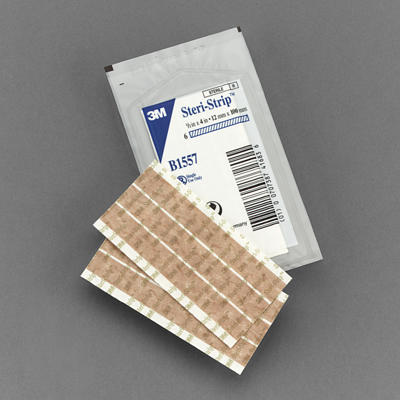Product Description
Steri-Strip Blend Tone Skin Closures are sterile, light beige skin closure strips made of a porous, non-woven backing coated with a pressure-sensitive, hypoallergenic adhesive. Steri-Strip Blend Tone Skin Closures blends with and allows the natural skin tone to show through and are appropriate for use in areas where a cosmetically pleasing appearance is desirable, such as the face or arms.
Frequently Asked Questions
Question: Do Steri-Strip Blend Tone skin closures contain latex?
Answer: No. Neither the packaging nor the Steri-Strip skin closures contain natural rubber latex.
Question: Are Steri-Strip Blend Tone skin closures hypoallergenic?
Answer: Yes.
Question: What is the shelf life of Steri-Strip Blend Tone skin closures?
Answer: 5 years. The expiration date may be found on the top of each Steri-Strip skin closure package. Without breaking the seal, fold the rear package flap back. Holding the package up to the light, you will note: LOT, hourglass, year, 1 -2 numbers, several letters. The hourglass symbol represents the expiration date. 2004-10 would indicate that the product will expire in October of 2004.
Question: Are Steri-Strip Blend Tone skin closures sterile? Can Steri-Strip Blend Tone skin closures be resterilized?
Answer: Steri-Strip Blend Tone skin closures are sold sterile. They may be resterilized with ethylene oxide if the product is removed from the envelope.
Question: What is the best way to get great adhesion of Steri-Strip skin closures?
Answer: Steri-Strip skin closures adhere best to clean, dry skin. This can be accomplished by ensuring that bleeding is under control and cleaning the skin with saline or alcohol to remove oils or exudates followed by gentle drying of the skin surface. Steri-Strip closures have a pressure sensitive acrylate adhesive. Adhesion of skin closures will be enhanced if you gently but firmly press or stroke the skin closure strip during application so that the adhesive gets into the nooks and crannies of the skin surface. Steri-Strip skin closures were designed for closure of low-tension wounds. They are contraindicated for use in high-tension wounds that cannot easily be approximated with fingers or forceps or on infected wounds.
Question: Should I use a skin tackifier under Steri-Strip skin closures?
Answer: Compound benzoin tincture (CBT) may be used to increase adhesion of Steri-Strip skin closures. Although, CBT does not contain iodine, it may be an irritant to some individuals and should not enter the wound.
Question: What can I do to protect very fragile skin?
Answer: Apply the skin closure to dry, clean skin that is free of chemicals. If hair is to be removed, a clipper should be used. To further protect from adhesive trauma, a skin barrier such as 3M Cavilon No Sting Barrier Film may be applied and allowed to dry thoroughly before applying the skin closure. Avoid chemicals designed to increase adhesion. To reduce the risk of skin stripping, gently remove Steri-Strip skin closures: low and slow, towards the center of the wound, while supporting the skin.
Question: What could cause blistering of the skin under the ends of skin closure strips?
Answer: The most common cause of blistering is tension. Edema, hematoma, or distention due to bloating may distort the skin surface. If the adhesive is firmly attached to the epidermis and the adhesive closure backing does not give, the epidermis may be pulled away from the dermis resulting in blisters or skin tears. Blistering is usually noted on both ends of the strip. A similar situation occurs when a joint or other area of movement is covered with a strip that doesnt stretch. If tension is noted, loosen, reposition, or replace the skin closure strips.
To decrease the risk of tension injuries:
- Do not use Steri-Strip skin closures on high-tension wounds.
- Apply Steri-Strip skin closures without tension. Do not strap the wound closed.
- Consider 3M Steri-Strip Elastic Skin Closures if edema, hematoma, distention, or movement are anticipated.
- Monitor the wound for evidence of swelling or blistering.
- If tension is noted under Steri-Strip closures, they may be replaced under the direction of a health care professional.
Question: I suspect that the area around the wound may swell. Will this affect the type of skin closure I should use?
Answer: Yes, if expansion or movement (such as over a joint) is anticipated, consider using 3M Steri-Strip Elastic Skin Closures
Question: How long can Steri-Strip skin closures be worn?
Answer: Steri-Strip skin closures are usually worn until they fall off or the healthcare provider removes them. This usually occurs within 5 to 7 days for the Steri-Strip Blend Tone skin closures. Wear time may vary depending on area of the body, skin type, degree of friction to that area, etc. Some health care providers prefer to remove, and sometimes replace, the Steri-Strip skin closures, on follow-up visits. The timing of strip removal and the length of continued reinforcement and support of the wound with skin closure strips is left to the discretion of the health care provider.
Question: If skin closure ends loosen, should they be trimmed?
Answer: Yes. Once the edges loosen, a skin closure strip is more likely come off than if the strip is intact. If the loosened ends of the strips are trimmed so that they do not catch on clothing, the duration of adherence is extended. However, when less than 1/2 inch of the strip remains on either side of the wound, health care providers may want to consider gently removing the strip and replacing it with a new strip.
Question: Can I get Steri-Strip skin closures wet?
Answer: Unless contraindicated, you may shower 24 hours after the Steri-Strip skin closures have been applied. Then pat the strips dry. However, some studies indicate that strip adherence may be improved when bathing is limited. For additional protection, you may cover the Steri-Strip skin closure with a 3M Tegaderm Transparent Dressing.
Six steri-strips per envelope, Two envelopes for a total of 12 steri-strips




